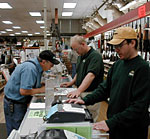By Tom Robertson
Minnesota Public Radio
September 5, 2002
Recent mild winters have allowed the deer population in Minnesota to flourish. Some people complain, there are too many deer. The Department of Natural Resources will offer a record number of permits this year. Many will allow hunters to shoot does and fawns. The goal is to reduce the size of the herd. The deadline to apply for antlerless permits is today. DNR officials hope hunters take advantage of the additional permits. But they're worried some hunters might skip the upcoming season because of growing concerns about chronic wasting disease.
| |
|
|
|
||
Hunters are lined up at the sales counter of Kobilka's Sporting Goods in Bemidji. Employees say sales of hunting permits for the firearms deer season are brisk.
"This shows that I entered you in the antlerless lottery. And that shows that I put you in 248," says a sales clerk.
That means the hunter will likely get an antlerless permit. Those permits are the DNR's primary tool to reduce the size of the deer herd. Hunters who apply are placed in a lottery. This year, in most permit areas, every hunter who applies will get one. In fact, in some areas of northern Minnesota, hunters will have the opportunity to kill up to five deer. Store employee Jim Templin says there are lots of deer out there, and hunters are excited.
"People are looking at it as a good opportunity to ... get out and get their deer," Templin says. "They know they have to get the numbers down. If you do any amount of driving on the highways up here, you know, people can tell when the numbers (of deer) are up."
|
"I think people should go out there and enjoy their hunt. And they need to enjoy their venison also. And let's not jump to any conclusions about it. And we're safe until we hear otherwise."
- Kobilka's store clerk Jim Templin |
Severe winters in the mid-1990s caused deer populations to plummet by nearly 30 percent. But the winters since then have been mild, and the population has rebounded. Bemidji area hunter Terry Nord says he usually hunts for the meat. But this year he's doing it to protect his property.
"The deer population is just the largest it's ever been. They're in flower gardens all winter, pulling up hostas by the roots ... you know, shrubs next the the house," Nord says. "It's getting to be a little bit of a problem. They're fun to watch, nice to have around, but enough is enough."
Enthusiasm for this year's hunt is not shared by all. DNR officials say the threat of chronic wasting disease may keep some hunters out of the woods. The disease is a fatal, brain-destroying illness affecting deer, elk, moose and caribou. Minnesota's first confirmed case was discovered last week.
State Health Department officials reported one animal from an Aitkin County elk farm died from the disease. It has not been detected in wild deer in Minnesota. But DNR Wildlife Manager Steve Caron says the possibility is making some feel uneasy.
"There's mixed views out there from hunters," he says. "Some are really concerned and ... are going to choose not to hunt. We've heard from meat processors that they ... will possibly not process deer anymore."
| |
|
|
|
||
Caron says Natural Resources officials want hunters to watch for deer that are thin and weakened by the disease. Hunters should report those sitings, but not shoot the animals. They should wear rubber gloves when dressing their kills. And they should not touch the spine or brain, or consume any of the organs associated with the adrenal or nervous systems. Otherwise, Caron says hunters should not be afraid.
"We're just telling people to go and hunt as they normally do and harvest a deer and consume the deer, because we may come out clean on this this year," Caron says.
Kobilka's store clerk Jim Templin says his customers are asking questions about chronic wasting disease. But he says hunters don't appear to be all that worried.
"I think people should go out there and enjoy their hunt," he says. "And they need to enjoy their venison also. And let's not jump to any conclusions about it. And we're safe until we hear otherwise."
The DNR is taking swift action in response to Minnesota's first official case of chronic wasting disease. Beginning Monday, conservation officers will kill more than 100 deer near the quarantined elk farm in Aitkin County. Wildlife officials also plan to collect brain tissue samples from 5,000 deer during the firearms season.
Meanwhile, in Wisconsin, more than 30 deer have tested positive for chronic wasting disease. Officials in Wisconsin plan to kill up to 25,000 deer in an effort to eradicate the disease.
More from MPR

